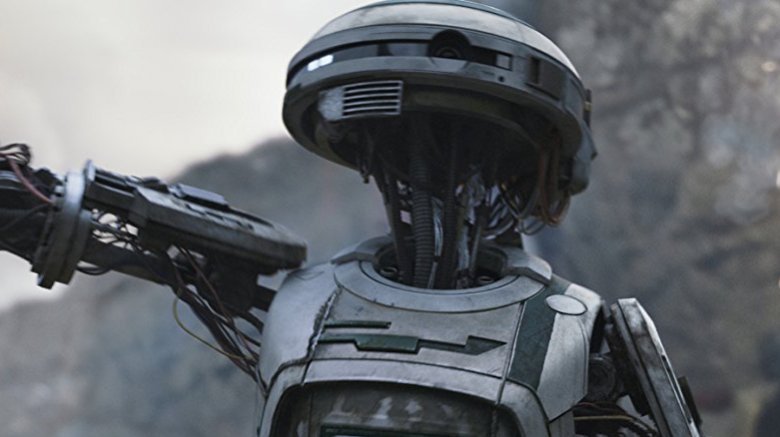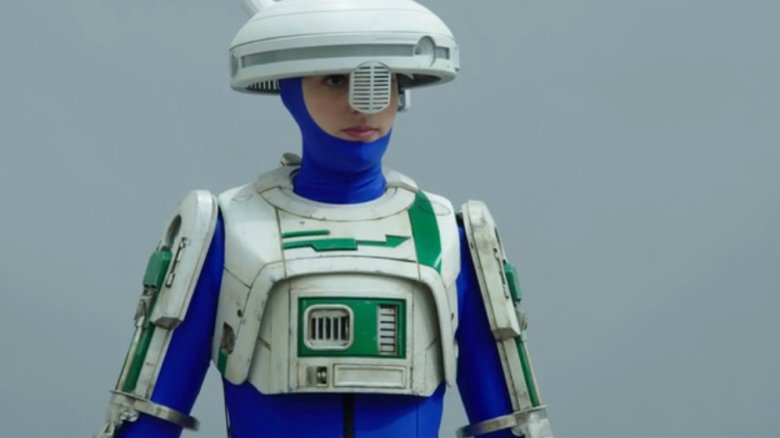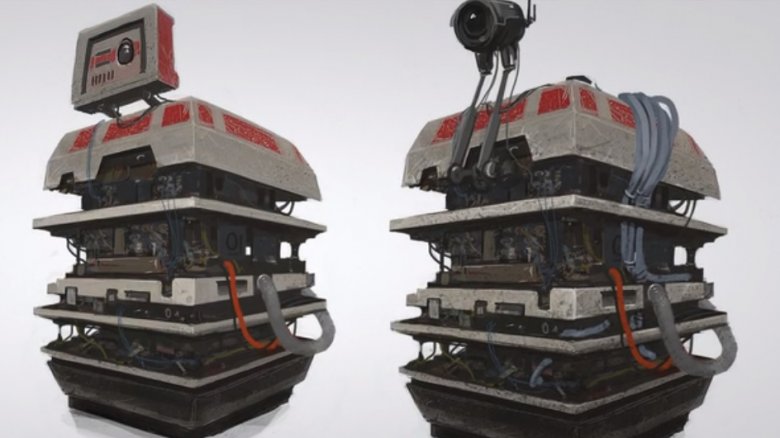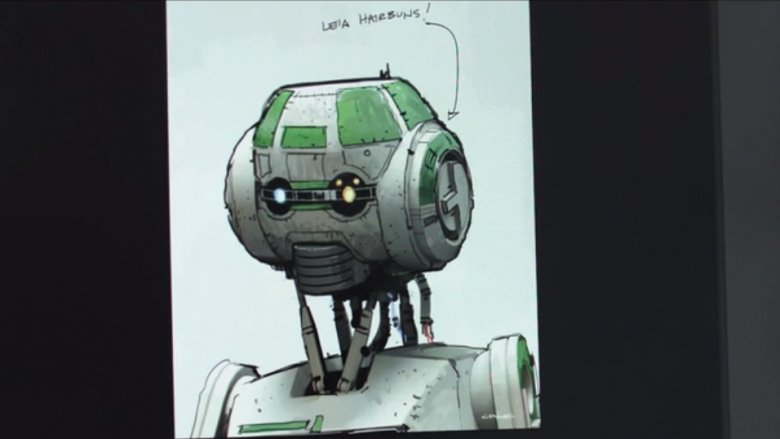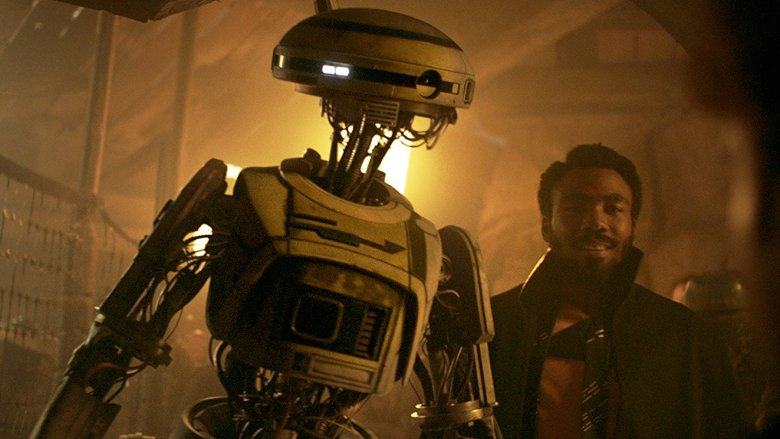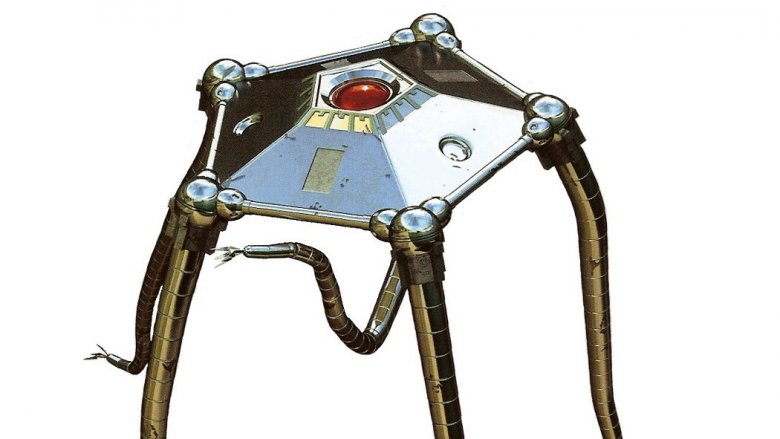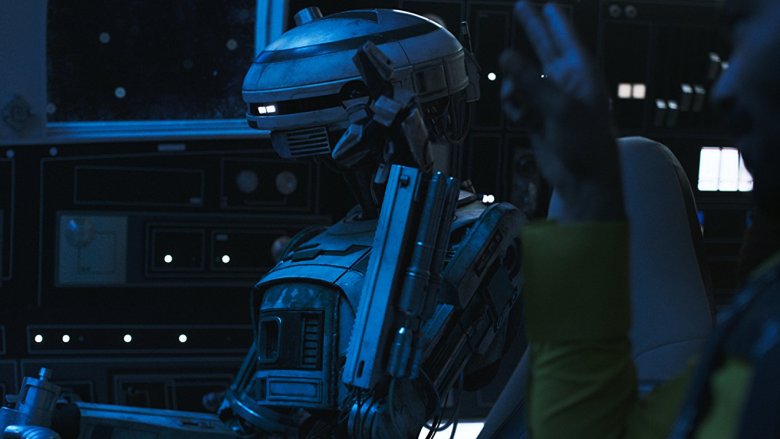Secrets Of L3-37 In Solo: A Star Wars Story Revealed
Thanks to its very nature as an origin story, Solo: A Star Wars Story didn't introduce a lot of new material to the wider Star Wars universe. But the additions it did make had an impact, and none did so with more revolutionary flair than L3-37, the aggrieved android co-pilot to Lando Calrissian.
The movie's opinionated navigator brought social justice rhetoric and a dose of mechanized rage to the outer space fantasy series. And though she didn't make it out of the movie in one piece, her essence did eventually become incorporated into some of the most iconic aspects of Star Wars, giving her a legacy that will continue throughout Disney's sequel trilogy and maybe even beyond.
Solo had a notoriously troubled production, with a high-profile director replacement and extensive reshoots causing major disturbances during the lead-up to the movie's release. The development of the L3 character specifically also went through its share of twists and turns, with more than a few dead ends on the way to the final product. In short, it took a lot of work to make the L3 we know. Let's see if we can flip the switch and divine the secrets of Solo's L3-37.
Human approach
We all know the feeling of going to class without having done all the homework. In the movie business, sometimes the homework is years upon years' worth of science fiction lore, and sometimes the class is a Star Wars audition.
A combination of CGI and live-action practical effects, L3-37 is played by Phoebe Waller-Bridge, an English writer, performer, and director who didn't exactly grow up watching Star Wars. During an appearance on The Graham Norton Show, she confessed that she'd actually never seen a Star Wars movie before her big audition took place. Even worse, she also never learned what exactly a droid was before she trekked out to try out for the potentially life-changing role.
"I was going to the audition and I thought, 'This character's amazing, she's a revolutionary, she's really cool, and the dialogue was amazing,'" she said. "But it kind of said just in one of the stage directions, 'droid.' So I was like, 'droid, droid... What's a droid?' And then I Googled 'droid' and then nothing much really came up, weirdly, just pictures. It wasn't explicit that it's a robot."
We'll put aside the fact that an incognito Google search, at the time of this writing, brings up the Wikipedia page "Droid (robot)" within two results. She clearly didn't need the intel — after all, she got the part.
Prototypes
L3-37's final design, which seems to evoke both a saucer-headed hourglass and an angry waitress at a diner, is a one-of-a-kind look among droids in the Star Wars galaxy. But the character wasn't originally conceived to look that way at all, according to the special features of Solo's home media release. In fact, L3 was designed at one point as a squat and compact droid with dimensions much more similar to smaller robots like BB-8 and R2-D2 than a taller, more humanoid variety.
As the movie itself details, L3 was eventually imagined as a singularly unique being who constructed and customized herself with the spare parts of many different droids from the Star Wars universe, from astromechs to slicers and everything in between.
Assuming it was ever under serious consideration, we don't know when the original, more diminutive droid design for L3 was abandoned. It feels like a version of the character that would have felt much more at home in the Lord and Miller comedy cut of the movie. It certainly would've been amusing to see a boxy droid with a big attitude rolling around espousing revolution left and right. Suffice to say, it also would've made that special physical attraction she's implied to have with Lando a whole lot more... technically fascinating.
Nice hair
Even as L3-37's design crept more toward familiar, bipedal territory, the design team behind the character continued to tweak her looks. They kept the idea that she had at one point been a smaller R2-D2-style droid, imagining that she had since constructed herself a set of arms and legs out of other, presumably defunct robots. (It'd be sort of screwed up if the great droid liberator made her bones recycling parts from functional, living droids, yeah?)
Glyn Dillon, a costume designer for Solo, spoke about the grab bag-style creation of the new droid in a behind-the-scenes interview. According to him, the final design both evokes nostalgic feelings and the sensation of seeing the new, with her mixed-up mechanical workings implying a very unique life story. "You get that feeling that she's very familiar, and at the same time it's a very new way of doing it," he said. "She's given herself a voice."
It wasn't just other robots of the Star Wars universe that were looked to for L3's design inspiration. James Clyne, Lucasfilm's design supervisor, said that he at one point also added Princess Leia-style hairbuns to a version of the robot's head. It's a move that would have made for yet another Easter egg in a movie already packed with callbacks — but as a look, we've gotta say that Carrie Fisher rocked it better.
Foreshadowing
After L3-37's body is destroyed in the movie during the madcap escape from Kessel, the character's brain is uploaded to the Millennium Falcon, thus fusing the ship's computer with her own. The implication is that the Millennium Falcon we know from the original Star Wars movie onward is powered, in part, by a snarky English robot who hates everybody and stars in Fleabag.
This particular tidbit was seemingly confirmed after the movie's release by the official Star Wars Twitter account, through a message reminding fans of the iconic ship's "peculiar dialect" toward C-3PO.
L3's kinship with the spaceship doesn't just kick in post-mortem. Speaking in a special feature for the Solo home media release, Skywalker Sound's supervising sound editor Matthew Wood said that many of the sound effects that make up L3's movements are the same sounds that were recorded for the Millennium Falcon's ship noises over 40 years ago.
"We had this idea that the sound effects that were created for the original Millennium Falcon back in the '70s [were sounds] I wanted to have used in her — in her being," Wood said. He referred specifically to a scene in which L3 bumps her head while making navigational calculations, resulting in a high-pitched whine. This noise and others can be found in the sound effects of the original movie, implying a direct connection between her character in Solo and the ship's computer in A New Hope.
"She is the navi-computer," Wood said. "That is what powers that ship in New Hope."
Spiritual sibling
Solo isn't the first time that the stories of young Lando and Han Solo have been told. Far from it — prior to Disney's purchase of Lucasfilm, Lando alone went on literally dozens of extracurricular adventures, most of which have now been relegated to the non-canonical Star Wars Legends label. And get this — he has a droid sidekick in those stories, too.
Before L3-37 stood (however standoffishly) at Lando's side, the galaxy's smoothest operator partnered up with a barstool-lookin' robot by the name of Vuffi Raa.
While L3-37's expanded universe precursor was a little bit more complicated of an organism than L3 turned out to be, they still have a lot of similarities. Like L3, Vuffi wasn't just any old droid. Vuffi came from a whole droid society, the Silentium, with origins in a galaxy far beyond the familiar worlds of Star Wars. Vuffi and Lando's relationship was also that of 50-50 partnership, with Vuffi working as a pilot and navigator for Lando. Members of Vuffi's species were also capable of improving on their own designs, with some eventually growing to be the size of starships.
You don't need to take our word for it that the similarities between Vuffi and L3 are strong. In Solo, Lando records a personal memoir of his adventures under the name "the Calrissian Chronicles." These puffed-up diary entries recount stories that copy the content of his Star Wars Legends adventures, with L3 being referenced as his partner in place of Vuffi. Poor guy.
Elite skills
Depending on how much (and how old) of a gamer you are, L3-37's name is either an obvious joke or an obscure reference. The name refers to leet speak, an early form of online communication in which numbers and keyboard symbols take the place of regular letters. Such diction is supposedly meant to be understood only by the most elite of gamers, hence the name, "1337".
As an online meme in 2018, the phenomenon of leet speak is long dead, usually only coming up nowadays for the sake of irony (or mockery). But in a time when computers and the internet still felt somewhat new, it was a handy way to signal the extent of one's nerdery, back before people were able to communicate entirely via emoji, Insta stories, and animated GIFs. For '90s kids, it hearkens back to an era of narrow bandwidth, dial-up, and Leeroy Jenkins.
You'd be a doofus to try and sincerely speak leet on today's internet, but in the context of a space fantasy movie, the reference is kind of cute. (It's not too hard to figure out which member of the father-son Kasdan writing team came up with that one.) Now we're wondering why they didn't go all the way with it, and seal the deal with an "All Your Base" reference. Maybe they were saving that for Solo 2.
